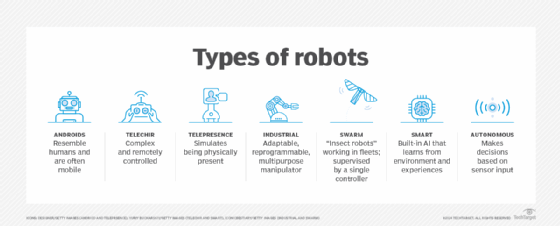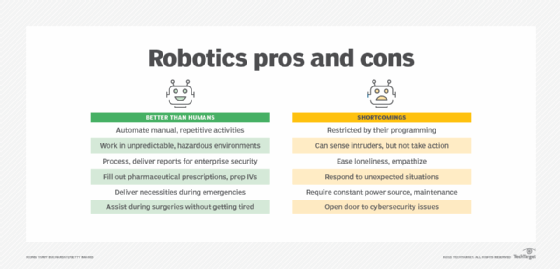robot economy
What is the robot economy?
The robot economy is a scenario in which most of the labor required to sustain human life is automated. Although the term robot economy brings to mind an environment full of humanoid robots -- or androids -- bustling about performing tasks, in this context, the word robot refers to both physical systems and software systems enhanced with artificial intelligence (AI), and it's the latter that are expected to replace the bulk of human work.
The lure of AI and robotics to organizations of all kinds is clear: With automation comes productivity, growth and reduced cost. Across the U.S., this means a corresponding increase in gross domestic product (GDP). Increasing efficiency, improving response times and reducing the workforce are always high priorities for organizations, and the use of robots and AI is increasingly a fast track to those benefits.
With the advent of ChatGPT and other generative AI tools, as well as the now-pervasive presence of automated workflow in business software platforms and machine learning (ML) applications, there are many revised predictions regarding the speed at which AI and robots will replace human workers.
A recent report published by Goldman Sachs Research estimates that AI and robotic systems could replace the equivalent of 25% of the 300 million full-time jobs by 2030. In addition, the report forecasts that two-thirds of the jobs in the U.S. and Europe could be exposed to some degree of AI automation.
Another report produced by the Massachusetts Institute of Technology and Boston University estimates that industrial robots will replace as many as 2 million human workers by 2025.
As jobs are displaced by automation, some people predict that new jobs will be generated to fill the employment gap. Others, however, maintain that the scale of displacement will be of such a magnitude that any new jobs generated won't be able to keep up with the needs of former workers or are likely to be candidates for automation as well.
The crux of the matter is that software is inherently less expensive than human labor. Robots and software have up-front costs but after acquisition, they're generally inexpensive to operate and maintain and don't require salaries, sleep or vacations.
AI technology is also becoming more sophisticated and is being adopted by businesses at an ever-increasing rate. Software robots -- systems that run on a host device rather than existing as a standalone machine -- include expert systems, virtual assistants and other chatbots.
These systems are sometimes given robotic personalities like Apple's Siri and Amazon's Alexa and natural language facilities to seem more human-like and communicate more effectively.
Less interactive AI systems often replace human labor without particularly resembling a human, however. Robotic process automation (RPA) applies AI and ML capabilities to handle high-volume, repeatable tasks that previously required a human to perform.
The capacity to be aware of contexts and adapt to exceptions, changing conditions and new situations means that RPA can perform more complex human tasks than earlier IT automation technologies were capable of doing.
Proposed measures to deal with workers displaced by robots include a universal basic income, not a large sum but adequate to meet the needs of payees. Some IT experts have suggested that a robot tax could be levied to help fund the program.
What are the different types of robots?
Robots come in many shapes, sizes and forms. As noted above, some are physical machines, while others consist entirely of software. Major types of robots include the following:
- Industrial robots. These robots have been around for decades and build everything from automobiles to computers. They can perform a wide range of assembly line tasks, including welding, painting, lifting and moving, picking and sorting, mechanical cutting and assembly.
- Smart robots. From chatbots to generative AI to smart workflows, these robots are making their way into the home and workplace. They range from digital assistants that help with family tasks to augmented-AI applications used by skilled workers. The use of robots like these is becoming ubiquitous because they aren't big, expensive machines, but primarily made of software, making them inexpensive to produce and deploy.
- Military and emergency response. The military uses robots that are controlled remotely by soldiers to perform dangerous tasks like searching for mines and clearing out buildings. These remotely controlled telechirs -- which are also used by law enforcement, emergency response teams and hazardous waste disposal teams -- include drones and telerobots.
- Autonomous robots. Airplanes have been largely flying themselves for years with the help of their human pilots. Shipyards and factory floors use automated lifts and trucks, and fully robotic trucks for interstate delivery are in the testing stage. AI-supported personal transportation is beginning to appear commercially, and fully automated cars and other personal vehicles will be tomorrow's news.
- Telepresence. Zoom and teleconferencing products like it foreshadowed the emergence of telepresence robotics -- AI that can place a person in another location virtually. One example is the use of telepresence in medical care. Doctors can use these robots to check in with their patients remotely. The continuing evolution of virtual reality systems and the low cost of virtual reality hardware could significantly increase the use of telepresence robotics.
- Bio robots. These robots are designed to mimic nature. Boston Dynamics' dog-like robot named Spot is an example of this type of robot. Spot can be used to provide insight into industrial site inspections and potentially hazardous situations and can be deployed both manually and autonomously.
- Android robots. Science fiction has been embedding the android in the public gestalt for many decades, from Star Trek's Commander Data to the Terminator in the movie of the same name. In the real world, the market for these human-like robots is expected to reach $38 billion by 2035, according to Goldman Sachs Research. These robots appear in food service, patient care settings and warehouses.
- Swarm robots. Insect-like robots working in fleets manipulated by a single controller are just beginning to become commercially available, but their use in military, manufacturing and agricultural applications is actively being pursued.

What are the advantages and disadvantages of robots?
The benefits of robots and AI in all these domains include the following:
- Robots and AI make processes more efficient, consistent and reliable.
- They can almost always perform work faster and more accurately than human beings.
- They enhance worker and facility safety, as they can take on high-risk jobs and work in hazardous environments.
- After an initial investment, robots and AI are less expensive to support and maintain than human workers.
- They're often more productive and precise and can perform 24/7.
On the other hand, robots and AI have the following downsides:
- For the most part, robots and AI can only perform rigidly defined tasks in a narrow range.
- They can have a negative environmental impact.
- They're often costly to implement, requiring major infrastructure changes.
- There's the fear that the impact of robots on the human workforce could be socially and economically catastrophic.
In the case of AI, there are growing concerns that the deep learning systems that drive some applications are black box mechanisms whose inner workings can't be fully explained, leading to potentially dangerous legal issues and accountability concerns.

What are the economic impacts of AI and robots?
The problem of mass human job displacement notwithstanding, the immediate impact of robots and AI on business and society includes productivity growth and corresponding economic growth, wherever they come into use. There's further economic impact in the increased safety that ensues with the presence of AI and robotic systems in manufacturing and logistics, as robotic systems monitoring robotic hardware in those environments can engage in perpetual fault prediction and equipment replacement.
In healthcare, the impact of robots and AI is already profound, as improved outcomes realize massive savings across the care provider spectrum. Robots can carry out tasks that can improve patient care and safety. Robots like the da Vinci Surgical System are being used by many medical facilities for minimally invasive surgeries.
Even in narrow domains, the economic growth that robots and AI stimulate can be staggering. In finance, for example, AI-driven fraud detection and investment opportunity identification -- along with AI applications in risk mitigation and task automation -- could increase global GDP by $7 trillion over the next 10 years, according to Goldman Sachs Research.
Which companies are using robots and AI?
Thousands of companies are using robots and AI in a wide range of applications, including the following:
- Mitsubishi and Kawasaki produce manufacturing robots for all factory floor applications -- and their robots are in turn produced by robots.
- Amazon Robotics. In addition to using robots extensively in its fulfillment centers, Amazon has a division that designs and builds robots for factory floor work.
- Netflix. The streaming giant has revolutionized its industry by pioneering the AI-driven predictive systems that generate content recommendations and analyze customer preferences.
- Exxon Mobile is using AI to monitor field equipment and predict failures.
- Boeing has begun incorporating AI into air traffic management as well as vehicle inspection processes.
- Ikea has phased out its call center staff and is using a chatbot for customer service. The company has conscientiously upskilled the affected workers by training them to become interior design advisors.
Learn which skills are important for white-collar workers to learn to remain competitive in organizations that are using AI.






